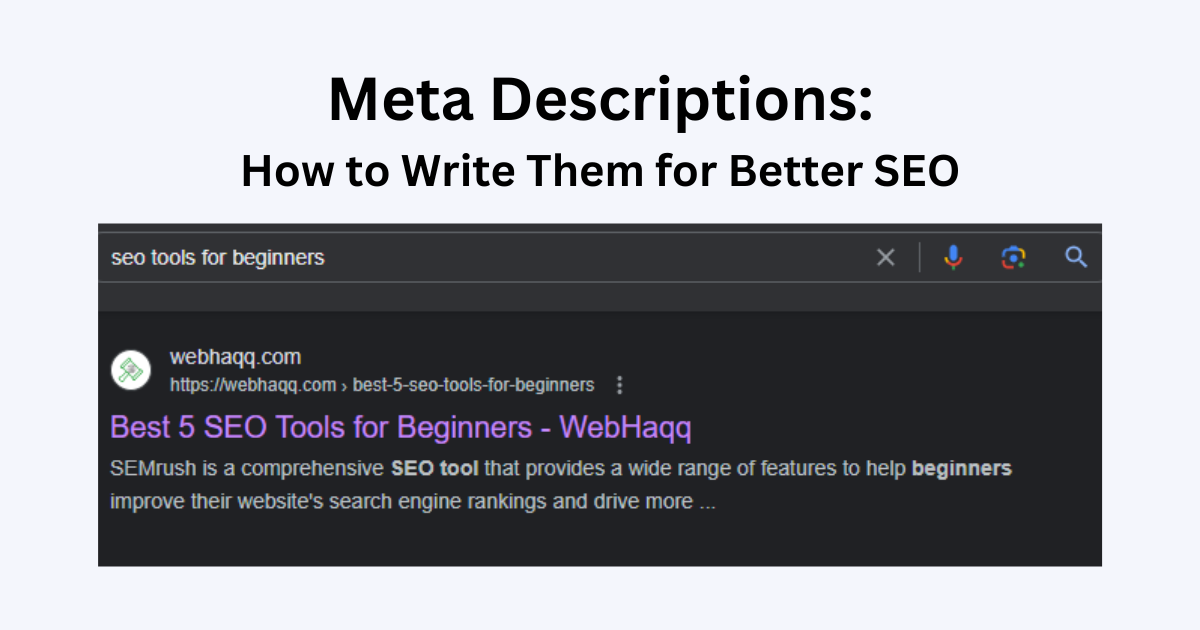In the world of SEO (Search Engine Optimization), every little detail can make a difference in how your website performs in search engine rankings. One of these crucial elements is the META description. In this article, we will dive deep into the importance of META descriptions in SEO and understand how to craft effective ones to enhance your website’s visibility and drive more organic traffic.
Table of Contents
ToggleUnderstanding META Description
A META description is a condensed paragraph of text that summarises a web page’s content. It is an HTML tag located within the head section of a webpage and does not appear directly on the page itself. Instead, search engines like Google and Bing display the META description below the page title in search results, providing users with a preview of what the page is about.
Importance of META Description in SEO
Although META description does not directly impact search engine rankings, it plays a crucial role in attracting users and influencing their decision to click on your website. Here’s why META descriptions are of utmost importance in SEO:
1. Improved Click-Through Rates (CTRs)
A well-crafted META description can entice users to click on your website when it appears in search results. By providing a concise and compelling summary of your web page’s content, you have an opportunity to increase click-through rates and drive more organic traffic to your site.
2. Enhanced User Engagement
By aligning the expectations set by the META description with the actual content of your page, you can improve user satisfaction and keep them on your site longer, thereby sending positive signals to search engines.
3. Increased Search Engine Visibility
While META descriptions do not directly influence search engine rankings, they indirectly impact your website’s visibility. When users find your META description compelling and relevant, they are more likely to click on your website, which can lead to higher organic click-through rates (CTR). Higher CTRs can send positive signals to search engines, indicating that your website is relevant and valuable for specific search queries, potentially improving your rankings over time.
4. Opportunity for Keyword Optimization
Including relevant keywords in your META description can potentially improve your website’s visibility for specific search queries. Although search engines do not consider META descriptions as a primary ranking factor, they may bold the keywords in the description that match the user’s search queries, making your listing more visually appealing and further increasing the chances of obtaining a click-through.
Crafting Effective META Descriptions
Crafting effective META descriptions requires a strategic approach to ensure they accurately represent your webpage’s content while enticing users to click through. Here are some tips to create compelling META descriptions:
1. Keep It Concise and Relevant
For META descriptions to avoid being cut short in search results, they should be between 50 and 160 characters. Be clear and concise, summarizing the main idea of your webpage compellingly. Focus on the unique selling points (USPs) or key benefits of the content to entice users.
2. Use Keywords Wisely
Include relevant keywords naturally within your META description, preferably towards the beginning. This helps both search engines and users understand the relevance of your webpage to specific search queries.
3. Maintain Consistency
Ensure that the content of your webpage aligns with the promises made in the META description. Misleading users with unrelated content can harm your website’s reputation and result in high bounce rates. Trust and user satisfaction are key factors in building a successful online presence.
4. Incorporate Action Words or Call-to-Action (CTA)
When possible, use action-oriented language or include a compelling call-to-action in your META description. This can motivate users to click through and engage with your content. For example, phrases like “Discover the secrets to…” or “Learn how to…” can pique users’ interest and encourage them to visit your website.
5. Unique and Differentiating
Make your META description unique and stand out from your competitors. Highlight what sets your webpage apart and why users should choose your content over others in the search results. Be sure to consider the searcher’s intent and appeal to their specific needs or interests.
6. Test and Optimize
Monitor the performance of your META descriptions using tools like Google Search Console or third-party SEO tools. Analyze the click-through rates and make adjustments as necessary. A/B testing different versions of your META descriptions can help identify the most effective ones to drive better results.
Conclusion
In conclusion, the META description is a crucial element in SEO that can significantly impact your website’s performance in search engine rankings. While it may not directly affect rankings, it plays a vital role in attracting users, improving click-through rates, enhancing user engagement, and increasing search engine visibility. A well-crafted META description can entice users to click on your website when it appears in search results. By providing a concise and compelling summary of your web page’s content, you can increase click-through rates and drive more organic traffic to your website. When users find a META description that accurately represents the content they are searching for, they are more likely to engage with your website, reducing bounce rates. Aligning the expectations set by the META description with the actual content of your page improves user satisfaction and sends positive signals to search engines.



